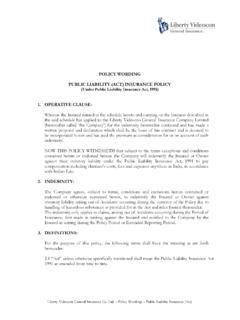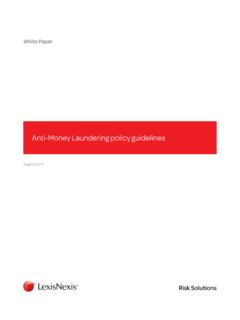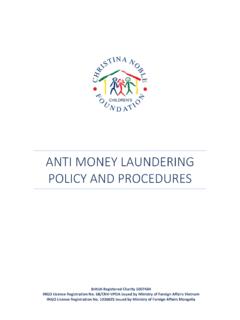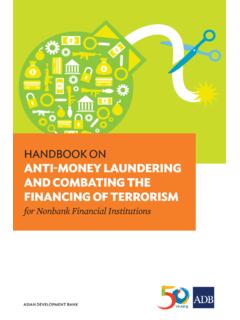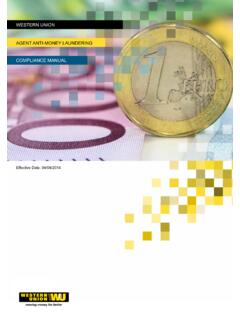Transcription of Anti-Money Laundering (AML) - IRDAI
1 Master Circular Anti-Money Laundering (AML). (Updated upto 31st October 2008). Insurance Regulatory and Development Authority Parishram Bhavan, 3rd Floor, Basheerbagh, Hyderabad 500 004. Phone No: +91-40-23381300. Fax No: +91-40-66823334. INDEX. anti money Laundering programme for Insurers Sl. No. Particulars Page No. 1. Background 1. 2. What is money Laundering ? 1. 3. AML Program 2. Internal policies, procedures , and controls 2. Know Your Customer (KYC) 2. When should KYC be done? i. Knowing New Customers 4.
2 Ii. Knowing Existing Customers 4. KYC and Risk Profile of the Customer 5. Products to be covered 5. Sources of Funds 6. Defining Suspicious Transactions (including 6. Suspicious Cash Transactions). Reporting of Suspicious Transactions 6. Monitoring and Reporting of Cash Transactions 7. Verification at the time of redemption/surrender 7. Record Keeping 7. Compliance Arrangements 8. Appointment of Principal Compliance Officer 9. Appointment 9. Responsibilities 9. Recruitment and Training of employees/agents 9.
3 Internal Control/Audit 10. Annexure I Customer Identification Procedure 12-13. Annexure II Vulnerable Products 14. Annexure III Income Proofs 15. Annexure IV Illustrative list of Suspicious Transactions 16. Annexure V List of Circulars 17. Master Circular on anti money Laundering (AML) for Insurers 1. Background: The Prevention of money Laundering Act, 2002 brought into force with effect from 1st July 2005, is applicable to all the financial institutions which include insurance institutions. The application of Anti-Money Laundering measures to non-depository financial institutions generally, and to the insurance companies in particular, has also been emphasized by international regulatory agencies as a key element in combating money Laundering .
4 Establishment of anti money Laundering programs by financial institutions is one of the central recommendations of the Financial Action Task Force and also forms part of the Insurance Core Principles of the International Association of Insurance Supervisors (IAIS). Accordingly, the Authority has decided to put in place the following regulatory guidelines/instructions to the Insurers, Agents and Corporate agents as part of an anti money Laundering Programme (AML) for the insurance sector. Insurers offer a variety of products aimed at transferring the financial risk of a certain event from the insured to the insurer.
5 These products include life insurance contracts, annuity contracts, non-life insurance contracts, and health insurance contracts. These products are offered to the public through trained agents of the insurance companies and also through a number of alternate distribution channels like direct marketing, bancassurance etc. The guidelines are therefore of importance to the agents and corporate agents also, to the extent indicated in the guidelines. The obligation to establish an Anti-Money Laundering program applies to an insurance company, and not to its agents, and other intermediaries.
6 Hence the responsibility for guarding against insurance products being used to launder unlawfully derived funds or to finance terrorist acts, lies on the insurance company, which develops and bears the risks of its products. 2. What is money Laundering ? money Laundering is moving illegally acquired cash through financial systems so that it appears to be legally acquired. There are three common stages of money Laundering as detailed below which are resorted to by the launderers and insurance institutions which may unwittingly get exposed to a potential criminal activity while undertaking normal business transactions: - Placement - the physical disposal of cash proceeds derived from illegal activity.
7 Layering - separating illicit proceeds from their source by creating complex layers of financial transactions designed to disguise the source of money , subvert the audit trail and provide anonymity; and Integration - creating the impression of apparent legitimacy to criminally derived wealth. If the layering process has succeeded, integration schemes place the laundered proceeds back into the economy in such a way that they re-enter the financial system appearing to be normal business funds. Financial institutions such as insurers are therefore placed with a statutory duty to make a disclosure to the authorized officer when knowing or suspecting that any property, in whole or in part, directly or indirectly, representing the proceeds of drug trafficking or of a predicated offence, or was or is intended to be used in that connection is passing through the institution.
8 Such disclosures are protected by law, enabling the person with information to be able to disclose the same without any fear. Insurance institutions likewise need not fear breaching their duty of confidentiality owed to customers. 3. AML Program In order to discharge the statutory responsibility to detect possible attempts of money Laundering or financing of terrorism, every insurer needs to have an AML. program which should, at a minimum, include: Internal policies, procedures , and controls;. Appointment of a Principal compliance officer.
9 Recruitment and training of employees/agents;. Internal Control/Audit;. The above key elements of the AML programme are discussed in detail below: Internal policies, procedures , and controls: Each insurance company has to establish and implement policies, procedures , and internal controls which would also integrate its agents in its Anti-Money Laundering program as detailed below: Know Your Customer (KYC): Considering the potential threat of usage of the financial services by a money launderer, insurance company should make reasonable efforts to determine the true identity of all customers requesting for its services.
10 Hence effective procedures should be put in place to obtain requisite details for proper identification of new customers. i. A list of documents to be verified at the time of accepting the risk for compliance with KYC requirement for individuals and others is given in Annexure I. The documents mentioned in Annexure-I for establishment of identity and residential proofs may be deemed as illustrative only. It is further clarified that no further documentation is necessary for proof of residence where the document of identity submitted also gives the proof of residence.






